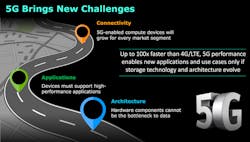The arrival of 5G is expected to bring an unforeseen level of network capabilities and lightning-fast data-transfer rates. 5G has the potential to reach latencies of less than 10 ms, which would be between four to five times faster than current 4G speeds. The speed of the network and its massive capabilities will change how data can increasingly improve our lives with the valuable insights it provides.
For example, although we’re some steps away from the all-independent self-driving car, connected cars are getting smarter and omnipresent by the day. Inspired by rich mobile user experiences, cars are evolving into mobile devices with high-resolution screens, customizable interfaces, the ability to update and install applications, and more immersive features.
With sensors, cameras, safety, and entertainment features, cars are becoming a massive data-creation hub, or a data center on wheels, enabled by 5G networks. And as vehicle-to-vehicle (V2V) communications evolve, the speed at which data is transferred becomes potentially life-changing.
Then there’s the wider world of sensors, machines, and connected devices. There are more networked devices than people in the world, and some predict that half of the global connected devices and connections will be M2M connections by 2023.1
Virtually every market segment and industry will see a growth of 5G-enabled devices. But these devices can only exist if they have the architectures to support them.
Why We Need Architectural Changes
Let’s talk about the most ubiquitous device—the smartphone. One architectural challenge is that many of today’s common standards for storage in phones, such as e.MMC, aren’t optimized for 5G. An embedded non-volatile memory system, e.MMC is comprised of both flash memory and a flash-memory controller, which simplifies the application interface design and frees the host processor from low-level flash-memory management. e.MMC 5.1 can still meet the demand for some devices migrating initially from 4G to 5G. However, the Universal Flash Storage (UFS) interface aligns best with most 5G devices because of its high gigabit-per-second-level throughputs.
To enable the 5G era, we need to think differently about how to optimize architectures with the right storage for the right applications. Storage wasn’t the bottleneck for 4G networks. Far from it. Devices that relied on a 4G link could take advantage of all existing common storage interfaces and easily saturate their link.
But 5G means changing how we think about storage design. There are questions of connectivity, latency (how quickly can we get data onto devices), cost (how to economically manage terabytes of data), power (writing data requires lots of energy), and privacy that require us to rethink how we move data more efficiently and help unlock more value.
Why 5G Needs UFS
In 2009, the average e.MMC embedded flash drive capacity ranged from 2 to 8 GB. By 2014, the average capacity rose to 16 GB+ and continued to increase from that point on.2
Along with capacity increases, new embedded technologies have emerged. A few years ago, UFS first entered the market. UFS offers higher performance, capacities, and power efficiency compared to the e.MMC interface, and offers complementary choices for those designing embedded systems.
5G will bring more complexity because each mobile device is expected to generate as well as consume several times more data than current devices. Higher 5G throughputs will drive richer content streaming such as real-time gaming. More advanced AI applications will add further complexity to the choice of storage. Considering storage early in the design phase to improve the performance of edge computing will be increasingly important.
The cost of flash has been dropping due to advances in technology, such as 2D to 3D migration and TLC to QLC. However, 5G-centric devices will need premium storage solutions. Different 5G mobile device form factors and capabilities are bound to have different requirements for storage, including performance, latency, IOPS, read/write speeds, data retention, capacity, temperature range, resilience, and more.
Storage Optimized for 5G Accelerates Performance
UFS brings faster speeds and responsiveness. With storage optimized to take full advantage of UFS 3.1 for 5G applications and capabilities, users can experience:
- Higher throughput at lower unit cost: 5G networks will have a much higher network capacity per cell (enabling extremely high user data rates or an extremely high number of simultaneous users) at a lower cost, i.e. the ability to connect a very large number of low-cost/low-power IoT devices resulting in low cost/bit metrics. This will be important for the future because data traffic is growing at a fast rate, and that will require 5G networks. The increased capacity and data rates will be achieved by improving the spectral efficiency via new antenna designs incorporating MIMO technology and beamforming, more efficient modulation schemes, higher-order modulations, new spectrum (low, mid and high frequencies) etc.
- Lower latencies: Typical round-trip time (RTT) latencies for 4G networks are around 40 to 47 ms. 5G is designed for latencies lower than 1 ms. These lower latencies will enable never-before-possible use cases, such as XR, immersive gaming, connected PC, etc. 5G offers multiple mechanisms for providing ultra-high reliability and low latency. These include antenna and frequency diversity, non-dynamic or collision-based uplink transmissions, adapted modulation and coding schemes for control and data channels, faster retransmissions, and new air interface frame structure and numerology.
- High device-connection density: 5G is being designed to offer wide area coverage for up to 1 million connected devices per square kilometer. Also, 5G will enable significantly lower connection cost per device. This will be important for IoT applications that involves many connected devices, e.g., smart cities. Although IoT devices such as smart meters are low-bandwidth devices and hence generate very little data traffic on mobile networks, they do create significant amounts of signaling data.
5G is designed to be flexible and efficiently handle very simple devices that only send small, infrequent bursts of data, as well as more advanced devices that send large amounts of data quickly.
Future Use Cases Enabled by 5G
5G could make content and media more immersive and responsive than ever with a well-planned storage architecture that’s able to take advantage of 5G’s higher bandwidth and low latency. If the infrastructure is constructed properly, the next wave of 5G could swing the door wide open to a few key technology fields, including:
AR and VR Gaming
A challenge to delivering the popular virtual-reality (VR) gaming technology has been tethering. VR headsets have historically been physically connected to a powerful smartphone or PC to fully render video games with minimal lag. It’s been the only way to handle the data processing and storage demands of VR video games. Similarly, augmented-reality (AR) goggles require more ubiquitous connectivity that provides high capacity, reliability, and cloud-computing capabilities for connected AR devices. But, a reality shift seems inevitable, thanks to recent developments.
Collectively, AR, VR, and mixed reality are being brought together as “extended reality,” or XR. 5G could lead to tether-less, 5G XR. Users could game with faster scene rendering and highly immersive gameplay using wireless headsets. They could also use real-world data augmented with digital information to make more informed decisions. The lower latency and higher bandwidth of 5G might further drive the adoption of smaller form factors that provide XR products with a better user experience and longer battery life.
Mobile Cloud Gaming
It was predicted that, in 2019, 2.4 billion people around the world would play a mobile game.3 While mobile and massively multiplayer online (MMO) gaming are popular, they’re not without their challenges—namely, player-server-player responsiveness. With 4G, longer latencies have sometimes meant slower and fragmented gameplay, which creates a less-than-ideal gaming experience. The problem is that mobile games currently rely on a remote cloud server for scene rendering, instead of processing on a user’s local device. Though this reduces the need for a huge processor on mobile devices and preserves battery life, it leads to increased latency.
5G, reaching potential latencies of less than 10 ms, coupled with a dedicated network slice along with edge computing, could bring the mobile gaming market to an inflection point. It could open new business cases and revenue streams for ads and in-game purchases, along with improved gameplay. Newer cloud-based game streaming services are starting to take measures for 5G connectivity. For mobile game developers, the goal is to make mobile gaming ubiquitous across smartphones, tablets, and connected PCs.
8K Video Streaming on Home TVs
Today’s high-end television sets are 8K, but they come with a hefty price tag and limited content libraries. Much of the content displayed on 8K displays, as of now, uses artificial intelligence to upscale lower-definition content (such as 4K TV shows or movies) into 8K resolution. One hurdle has been quickly moving all of that frame data—over 33 million pixels for a single frame—through home networks.
Using a 5G connection could alleviate some of these issues with streaming 8K content and save users from installing an ultra-high-speed, fixed-line home internet connection. Some TV suppliers are already developing 5G-enabled 8K TV sets. This built-in functionality could make it easier to connect to the broader 5G infrastructure being built out.
360-Degree, Total Field-of-View Content
A 360-degree, full field view of a sports stadium experience could be possible with the high bandwidth and low latency of 5G. Such 360-degree live sports content, e.g. photos and videos, could be viewed on 5G-enabled devices and shared on social media to increase engagement with fellow sports enthusiasts.
The future of 5G-enabled use cases is near and will have different storage requirements to unlock the speed and capabilities possible with 5G. Learn more about how the right storage solutions can meet these demands and help enable and augment devices that will generate and consume more data than ever in this whitepaper.
Itzik Gilboa is Senior Director of Mobile Segment Marketing at Western Digital.
References
1. Cisco Annual Internet Report (2018-2023) White Paper
2. Storage Demand for 5G Mobile Applications
Forward-Looking Statements
This article may contain forward-looking statements, including statements relating to expectations for Western Digital’s mobile storage products, the market for these products, and future capabilities and technologies for those markets. These forward-looking statements are subject to risks and uncertainties that could cause actual results to differ materially from those expressed in the forward-looking statements, including development challenges or delays, supply chain and logistics issues, changes in markets, demand, global economic conditions and other risks and uncertainties listed in Western Digital Corporation’s most recent quarterly and annual reports filed with the Securities and Exchange Commission, to which your attention is directed. Readers are cautioned not to place undue reliance on these forward-looking statements, and we undertake no obligation to update these forward-looking statements to reflect subsequent events or circumstances.
About the Author
Itzik Gilboa
Senior Director of Mobile Segment Marketing, Western Digital
Itzik Gilboa has held various technology roles at Western Digital including his current role leading the mobile flash storage component business, where he’s responsible for the marketing of branded mobile managed NAND products. He previously led the SanDisk-Toshiba alliance.
Prior to joining SanDisk/Western Digital in 2006, Itzik worked at Cypress Semiconductor as director of director of foundry operations. At Cypress, Gilboa helped develop four generations of manufacturing technologies for the production of SRAM devices. He’s the author of several patents in the area of manufacturing processes for SRAM.
Gilboa holds a Bachelor’s of Science degree in aerospace engineering and a Master’s of Science degree in materials science from the Technion, Israel. He also holds an MBA from San Jose State and a certificate in Strategic Decision and Risk management from Stanford School of Business.


